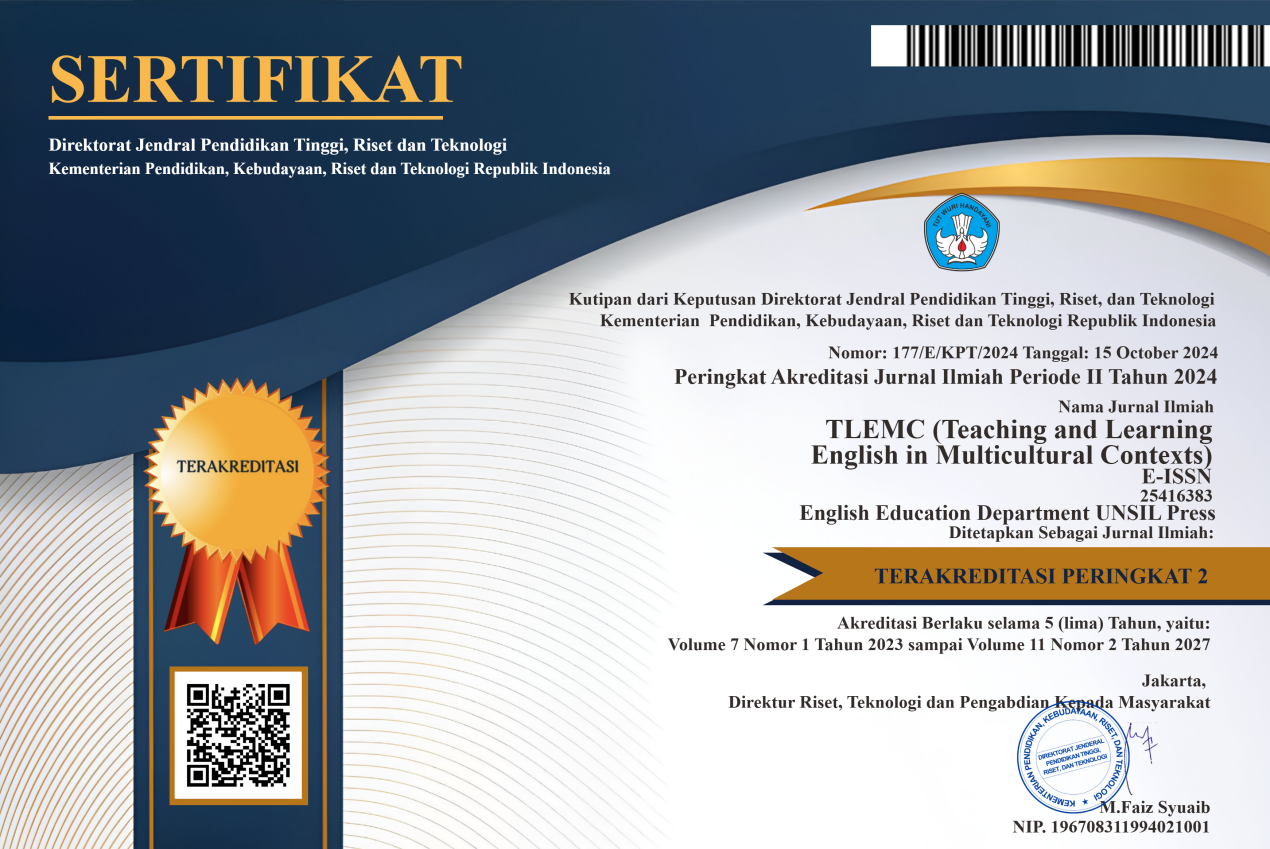Analyzing Grammatical Interference on EFL Students' Indonesian-English Translation
Abstract
Learning a foreign language is sometimes difficult since the target language has different elements and rules compared to the native language. When the students apply those elements and rules, it often leads to errors. In this case, when a student is learning a foreign language, the students’ native language will have an impact on the production of the language being learned which is called language interference. This study aims at investigating the types of interference and which type of interference appears more in EFL students’ Indonesian-English translation text. This study involved twenty students of the first grade in a senior high school in Cianjur. It is descriptive qualitative research with the data taken from students’ translation text that were analyzed by using error analysis to point out and describe the interference. The findings show that all participants of this research made errors in their translation text. In this case, four types of error found in the text, those were omission, addition, misformation, and disordering. The differences in the structures between two languages and different proficiency levels of students in target language led the students commited different error types in four error categories. The result of the analysis also shows that there were 413 errors found in the students’ translation text which consisted of 121 omissions (29,29%), 96 additions (22,27%), 156 misformation (38%), and 44 disordering errors (11%). From those frequencies, the most frequent error was misformation. Misformation indicates the use of an incorrect form of a certain linguistic in the target language utterance.
Keywords: Language Interference, Indonesian-English Translation, Translation Text, Error Analysis, Classification of Error
Full Text:
PDFReferences
Budiharto, R. A. (2019). Native Language Interference on Target Language Writing of Indonesian EFL Students: An Exploratoty Case Study. Indonesian EFL Journal, 5 (1). https://doi.org/https://doi.org/10.25134/ieflj.v5i1.1630
Creswell,J.W. (2013). Qualitative Inquiry & Research Design: Choosing among the five approaches. Thousand Oaks, CA: SAGE Publications, Inc.
Dulay, H., Burt, M., & Krashen, S. (1982). Language Two. Oxford University Press.
Ellis, R. (1994). The study of second language acquisition. Oxford: Oxford University Press.
Fitria, T. N. (2018). Translation Technique of English Abstract Translation in Journal Edunomika in 2018. ELITE Journal,5. https://doi.org/10.24252/elite.v5i2a4
Fernandez, E. M., & Cairns, H. S. (2017). The Handbook of Psycholinguistics (First Edit). https://doi.org/10.1002/9781118829516
Harlig, K. B., & Sprouse, R. A. (2017). Negative Versus Positive Transfer. TESOL International Journal, 12(2). https://doi.org/https://doi.org/10.1002/9781118784235.eelt0084
Hendrawaty, N. (2018). An Analysis on Students' Errors in Writing Sentence Patterns. LOQUEN: English Studies Journal,.11 (1). http://jurnal.uinbanten.ac.id/index.php/loquen/index
Helmie, J. (2014). The Use of Aids in TEFL (Teaching English as a Foreign Language): A Case Study at the MTS SA Al-Istiqomah in Ciheulang, Cianjur, West Java, Indonesia. ATIKAN: Jurnal Kajian Pendidikan, 4 (2) , pp.201-2016.
Irmalia, M. (2016). Indonesian Interference in Students’ Writing. English Education Journal, 7 (4), 496–508.
Karim, K., & Nassaji, H. (2013). First Language Transfer in Second Language Writing: An Examination of Current Research. Iranian Journal of Language Teaching Research.
Lekova,B. (2010). Language Interference and Methods of its Overcoming in Foreign Language Teaching. Trakia Journal of Sciences,8, (3), pp 320-324,2010
Maolida, E.H., Hidayat, M.V.C. (2021). Writing Errors Based on Surface Structure Taxonomy: A Case of Indonesian EFL Students’ Personal Letters. Proceedings International Conference on Education of Suryakancana 2021
Maolida, E.H.,Mustika, G. (2018). Students' Writing Process for Project Ibunka: A Case Study of EFL Writers. JELTL, 3(3),203-215. https://jeltl.org/index.php/jeltl/article/view/147
Maolida, E.H.,Salsabila,V.A. (2019a). Integrating Process-genre Approach with Project Ibunka to Improve Students' English Writing. English Review: Journal of English Education, 8(1),91-100. doi: 10.25134/erjee.v8i1.20157
Maolida, E.H., Salsabila, V.A. (2019b). The Integration of Process-genre Approach with Project Ibunka in an EFL Writing Class: Students' Writing Ability. JOEPALLT,7 (2), https://jurnal.unsur.ac.id/jeopallt/article/view/706
Muhammad, H., Magfirah, T. (2015). Error analysis in translating English from Indonesian of semester sixth students of Cokroaminoto Palopo University. IDEAS: Journal on English Language Teaching and Learning, Linguistics and Literature, 3 (2), https://doi.org/10.24256/ideas.v3i2.147.
Munday, J. (2008). Introducing Translation Studies (Second Edi). New York: Routledge Taylor & Francis Group.
Owji, Z. (2018). Translation Strategies: A Review and Comparison of Theories. Translation Journal, 17 (1). Retrieved from http://translationjournal.net/journal/63theory.htm
Puspita. (2021). Error Analysis of Indonesian Grammatical Interference in Students‘ English Composition. Buletin Poltanesa 22 (1). https://doi.org/10.51967/tanesa.v22i1.466
Richards, J. C. (2015). Error Analysis Perspective on Second Language Acquisition (Second Edi). USA: Routledge Taylor & Francis Group.
Ruminar, H. (2018). Grammatical errors in ESP students’ presentation across proficiency levels. EnJourMe (English Journal of Merdeka) : Culture, Language, and Teaching of English, 3 (1), http://jurnal.unmer.ac.id/index.php/enjourme/index
Rusmiati. (2019). Surface Strategy Taxonomy on Foreign Language Writing: A Study on Verb Tense Usage. Journal of Scientific Information and Educational Creativity, 20. https://doi.org/http://dx.doi.org/10.32672/si.v20i2.1453
Safa, A. J. (2018). An Overview of Cross-Linguistic Influence in Language Learning. Journal of Applied Linguistics and Language Research, .5
Sari, H.M., Sudarsono, Suhartono, L. (2017). A Grammatical Interference From Indonesian into English Translation. https://media.neliti.com/media/publications/216304-a-grammatical-interference-from-indonesi.pdf
Septiana, A.R. (2020). The indonesian grammatical interference on EFL students’ writing. J-Reall, 1(1). http://riset.unisma.ac.id/index.php/JREALL/article/view/5610
Sugiyono. (2012). Metode Penelitian Kuantitatif dan R&D. Bandung:Alfabeta.
DOI: https://doi.org/10.37058/tlemc.v6i1.4031
Refbacks
- There are currently no refbacks.
INDEXED BY:
This work is licensed under a Creative Commons Attribution-NonCommercial-ShareAlike 4.0 International License.
![]()
TLEMC (Teaching and Learning English in Multicultural Contexts)
Program Studi Pendidikan Bahasa Inggris
Fakultas Keguruan dan Ilmu Pendidikan
Universitas Siliwangi
Jl. Siliwangi No. 24 Kota Tasikmalaya - 46115
email: tlemc@unsil.ac.id





